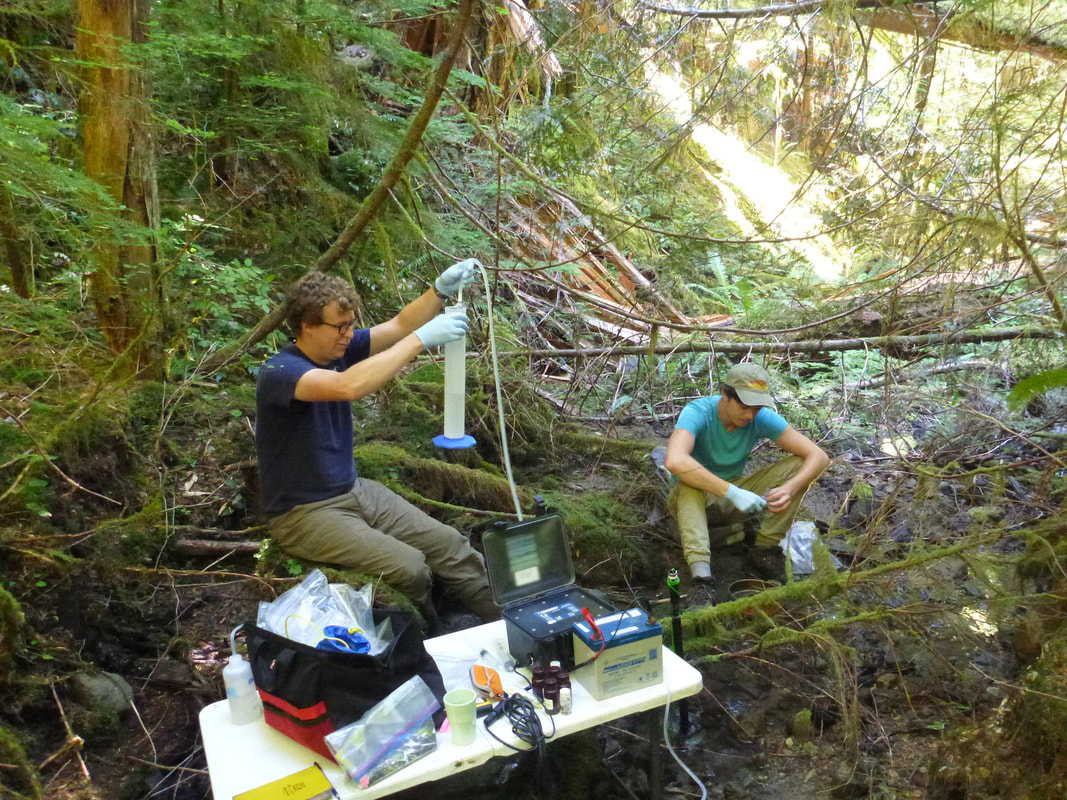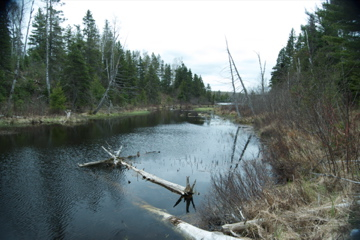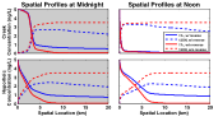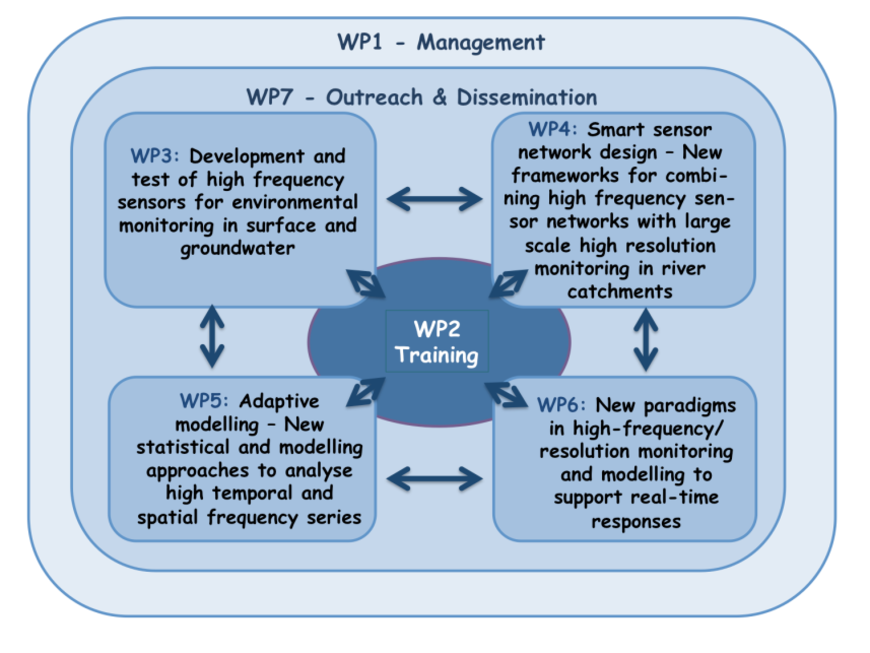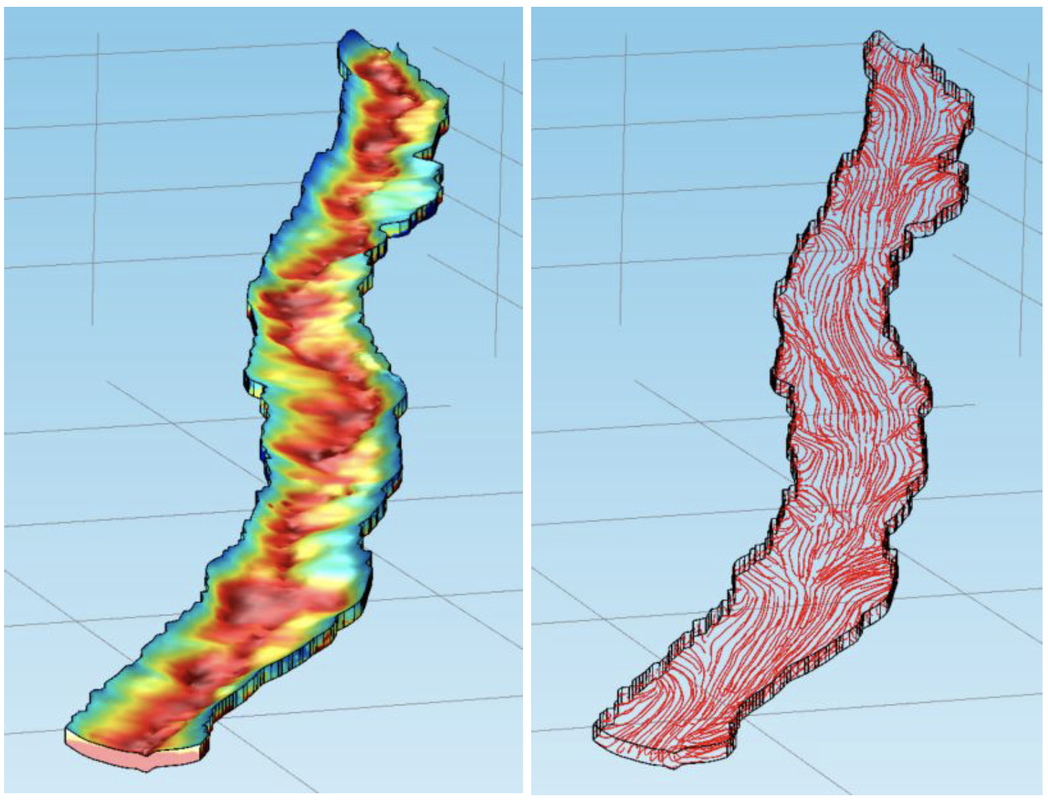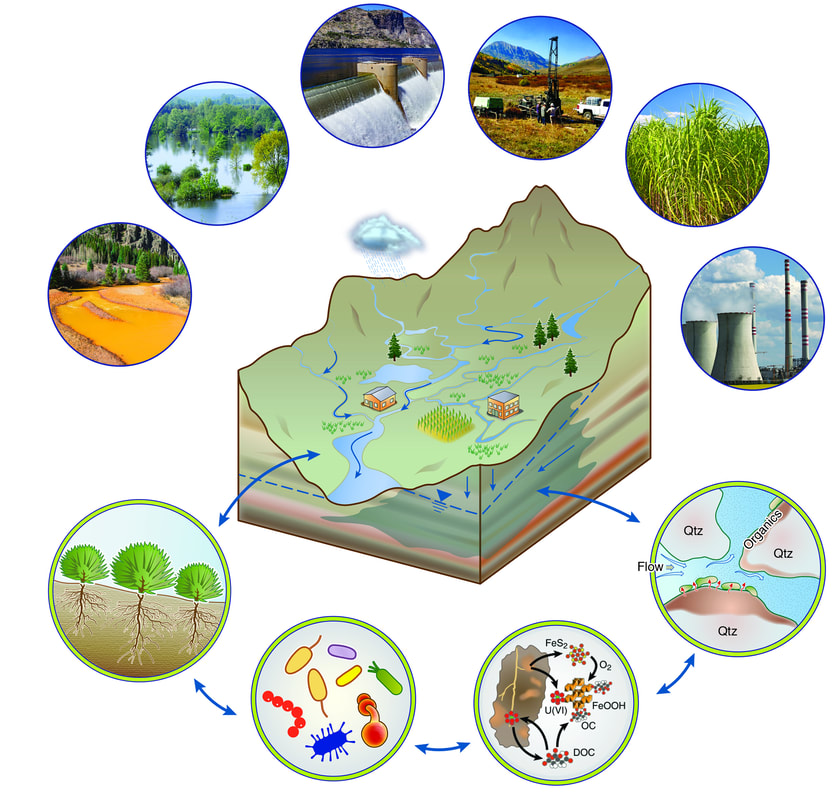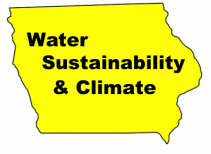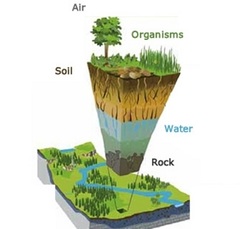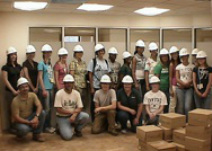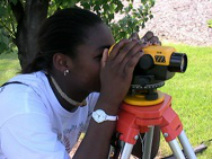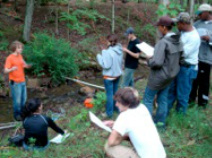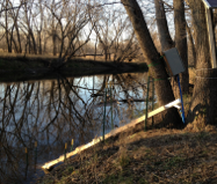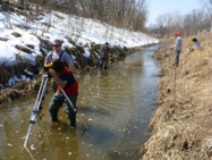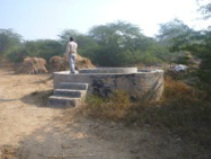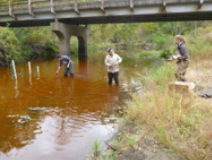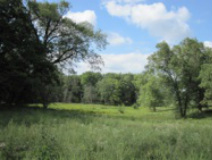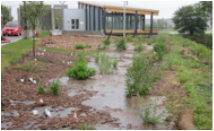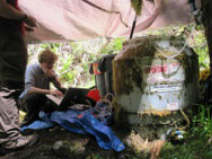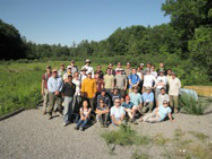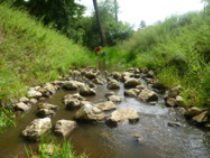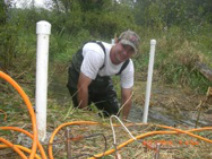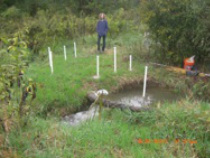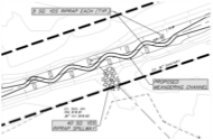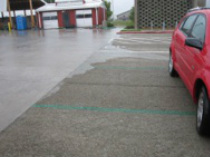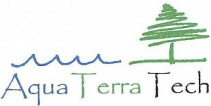Research interests
The exchange of water, solutes, and energy between rivers and their landscapes is crucial to water quality, ecosystem health, and ecosystem services derived from the river corridor. The connectivity between surface waters, hyporheic zones, riparian zones, floodplains, hillslopes, and aquifers – collectively termed “river corridor exchange” – is essential to these ecological benefits. River corridor exchange results in benefits including attenuation of nutrients, heavy metals, acid mine drainage, emerging contaminants, particles and sediment pollution, organic contaminants, and viruses and bacteria. The primary controls on river corridor exchange are broadly recognized to fall within two categories: geologic setting and hydrologic forcing. After decades of research, our ability to predict river corridor exchange as a function of geologic setting and hydrologic forcing, remains limited, with conflicting results reported for a majority of known controls.
My research program is motivated by four key advances that are required to significantly improve prediction of river corridor exchange and associated ecosystem services and functions:
Without advances in each of these areas, proactive and science-based management of river corridors for water quality, ecosystem health, and ecosystem services will not be possible. Motivated by the challenges articulated above, my scientific objective is to improve predictive understanding of fundamental physical, chemical, and biological processes in river corridors. Below, I review examples of past and ongoing research in each of these areas.
Finally, I also conduct research on higher education, including the use of innovative methods in the classroom, flipped or blended instruction, and making educational resources accessible to educators and students at all institutions (listed as heading "5." below).
My research program is motivated by four key advances that are required to significantly improve prediction of river corridor exchange and associated ecosystem services and functions:
- Improving our understanding of dynamic exchange processes in the river corridor;
- Advancing an interdisciplinary, systems approach to river corridor science;
- Extending existing feature-scale knowledge to the river reach and network scale; and
- Improving our understanding of feedbacks between humans and the hydrologic cycle
Without advances in each of these areas, proactive and science-based management of river corridors for water quality, ecosystem health, and ecosystem services will not be possible. Motivated by the challenges articulated above, my scientific objective is to improve predictive understanding of fundamental physical, chemical, and biological processes in river corridors. Below, I review examples of past and ongoing research in each of these areas.
Finally, I also conduct research on higher education, including the use of innovative methods in the classroom, flipped or blended instruction, and making educational resources accessible to educators and students at all institutions (listed as heading "5." below).
1. Improving our understanding of dynamic exchange processes in the river corridor
The hydrologic and geologic controls on exchanges in the river corridor are qualitatively understood under steady-state hydrologic conditions at scales of individual morphologic features. Critically lacking, however, is an understanding of how hydrological dynamics may enhance or dampen these exchanges and their associated ecosystem services. To that end, my research group has advanced conceptual models of river corridor exchange dynamics, developing and refining methods as we improve our ability to predict exchange and connectivity in the river corridor as a function hydrologic forcing. Strategic directions include (1) Advancing conceptual and mechanistic models of river corridor exchange and (2) Developing and refining tools to measure exchanges in the river corridor.
|
Advancing predictive understanding of hydrologic exchange in the river corridor
The specific knowledge necessary to predict and manage the fate and transport of contaminants within rivers is currently inadequate. This project will utilize a conceptual river corridor perspective that considers the surface water, near-surface sediments, the flood zone, the hillslope catchment and contributing groundwater aquifers as a continuum. The project will consider the exchange of water, solutes, energy and materials across a range of spatial and temporal scales and across these various compartments. The project focuses on three primary goals: (1) improve our understanding of dynamic exchange processes in the river corridor; (2) develop methods to scale findings from geomorphic features to the reach and network scales; and (3) improve predictive capacity that can be readily implemented without extensive field characterization of sites of interest. Results of this research will improve our ability to predict the transport and fate of contaminants in river corridors, enabling more effective management of water resources. The integrated education and research plans will inspire a diverse group of K-12 and undergraduate students to pursue careers in STEM fields. The project goal is to develop an integrated program of research and education focused on advancing the understanding of hydrologic exchange in river corridors and the associated ecosystem services and functions. The project will utilize a river corridor perspective that considers the surface stream, its hyporheic zone, riparian zone, hillslope, and aquifer as a continuum, exchanging water, solutes, energy and materials across a range of spatial and temporal scales. The proposed research will quantify spatial and temporal heterogeneity in river corridor exchange at the scale of individual geomorphic features and study reaches, and will synthesize results to develop predictive relationships of river corridor exchange along naturally occurring gradients in geologic setting and under hydrologic forcing. This research will specifically address three research questions: (1) What relatively static characteristics of geologic setting and hydrologic forcing cause predictable variation in river corridor exchange?; (2) To what extent is river corridor exchange controlled by the dynamic interaction between geologic setting and hydrologic forcing?; and (3) How transferable are predictive relationships and models of river corridor exchange? Research efforts are integrated with educational activities including K-12 education, mentoring high-school and undergraduate researchers, and teaching courses on River Corridor Science and Management at the graduate level. Funding Source: National Science Foundation Grant No. 1652293 PIs: Adam Ward (IU) |
2. Advancing an interdisciplinary, systems approach to river corridor science
Physical processes that control river corridor exchange provide the physical template upon which biological and chemical systems operate [Ward, 2016]. Advancing our understanding of physical processes, as above, is a first step in the prediction of ecosystem services and contaminant transport in the environment. In my research group, the extension of our physical science to interfaces with biogeochemistry and ecology are important themes. In all cases, my scientific advances are based upon collaborations with experts in complimentary disciplines such as environmental chemistry and aquatic ecology. These collaborations are exciting and lead to a more integrated understanding of river corridors, but require dedication to work across traditional disciplinary boundaries. Strategic directions include
|
Transport and fate of lampricides and their degradation byproducts
Many halogenated aromatic compounds, including the two lampricides 3-trifluoromethyl-4-nitrophenol (TFM) and 2’,5-dichloro-4’nitrosalicylanilide (niclosamide), undergo photodegradation. Although photodegradation can result in the loss of lampricide efficacy during dosing events, it also can reduce the persistence of the compounds after the treatment period. The proposed research aims to establish the role of photodegradation in the fate and lifetime of both lampricides in aquatic environments. Although the TFM photodegradation mechanism is understood, the niclosamide photodegradation mechanism has not been fully established and the photodegradation rates of both lampricides in natural water samples have not been adequately characterized. Furthermore, the registration review of niclosamide with the EPA requires quantification of its photodegradation in water. Funding Source: Great Lakes Fishery Commission PIs: Christina Remucal (Univ. of Wisconsin-Madison), Adam Ward (as a senior researcher) |
|
Water Quality Implications of Unique Transformation Processes of Synthetic Steroids.
Synthetic steroids are widely used in the animal agriculture industry. A common assumption is that such steroids are environmental benign because they rapidly undergo photolysis in environmental waters. Recent observations suggest that reversion from breakdown products back to the parent steroid occur under a host of temperature and pH conditions, and may widely occur in the near-stream hyporheic zone. In this study we couple laboratory experimentation with numerical modeling of streams, rivers, and lakes to quantify environmental transformation rates, and to identify locations on the landscape most at-risk to chronic exposure to synthetic steroids. Funding Source: USDA-AFRI PIs: Edward Kolodziej (Univ. of Nevada-Reno), Chris Jeffrey (Univ. of Nevada-Reno), David Cwiertny (UIowa), Adam S. Ward |
|
High-frequency sensors for quantifying hydrological dynamics across scales
Global environmental change is increasing pressure on the ecosystem services provided by hyporheic zones, the interface between surface water and groundwater. Currently, fragmentation of disciplinary scientific knowledge and the lack of an integrated conceptual process understanding prevent accurate assessment of hyporheic ecosystem functioning and resilience, thereby resulting in ineffective management of these key areas. We propose an international network designed to conceptualize the organizational principles and ecosystem functions of hyporheic zones as important ecohydrological, biogeochemical, and biodiversity hotspots. We will therefore combine unique, supra-disciplinary expertise to pioneer the combination of cutting-edge methodologies in a transferable scientific framework. Funding Source: EU Marie Skłodowska Curie Actions Research and Innovation Staff Exchange (RISE) PIs: HiFreq Proejct Team |
|
Where rivers, groundwater, and disciplines meet: a hyporheic research network
Global environmental change is increasing pressure on the ecosystem services provided by hyporheic zones, the interface between surface water and groundwater. Currently, fragmentation of disciplinary scientific knowledge and the lack of an integrated conceptual process understanding prevent accurate assessment of hyporheic ecosystem functioning and resilience, thereby resulting in ineffective management of these key areas. We propose an international network designed to conceptualize the organizational principles and ecosystem functions of hyporheic zones as important ecohydrological, biogeochemical, and biodiversity hotspots. We will therefore combine unique, supra-disciplinary expertise to pioneer the combination of cutting-edge methodologies in a transferable scientific framework. Funding Source: Leverhulme Trust PIs: Adam Ward, Stefan Krause (Univ. of Birmingham), Jay Zarnetske (Michigan State University), Scott Larned (National Institute of Water and Atmospheric Research), Thibault Datry (National Research Institute of Science and Technology for Environment and Agriculture), Eugenia Marti (Center for Advanced Studies of Blanes, National Research Council), and Jan Fleckenstein (Helmholtz Centre for Environmental Research). |
3. Extending existing feature-scale knowledge to the river reach and network scale
One important future direction for my research program is to translate findings at the feature and reach scales (1’s to 100’s of meters) to entire river networks (1’s to 100’s of kilometers), where water resources are managed. While these smaller scales of study have been and will continue to be fruitful for purposes of understanding hydrologic processes, that knowledge must be translated to the network scale in order to be made useful to resource managers. This area of research is the primary focus of two ongoing awards from federal agencies. Ongoing work in my group will continue to address this research topic through field experiments, numerical modeling, and monitoring at the scale of river basins. This is the subject of a recent invited commentary [Ward and Packman, 2019], and is a central focus in a large, collaborative proposal that I am currently leading to the National Science Foundation
|
Flowpath-to-basin forecasting of river corridor exchange.
Our overall objective in this proposal is to develop a predictive understanding of reach- and network-scale river corridor exchange using readily available topographic and hydrologic data. Our central hypothesis is that the efficacy of existing predictive capabilities is limited by an inability to represent process dynamics in response to hydrologic forcing. The rationale is that a focus on static hydrologic forcing and geologic setting has yielded site-specific, often opposing predictive relationships. Existing models fail to represent dynamic interactions and, therefore, are unable to represent responses of the river corridor to storm events and snowmelt runoff. Furthermore, synthesis of site-specific studies is limited, making transferability of findings a challenge. Funding Source: US Department of Energy PIs: Adam S. Ward, Steve Wodnzell (US Forest Service) |
|
Biogeochemical Transformations at Critical Interfaces in a Mercury Perturbed Watershed
Our overall objective in this proposal is to develop a predictive understanding of reach- and network-scale river corridor exchange using readily available topographic and hydrologic data. Our central hypothesis is that the efficacy of existing predictive capabilities is limited by an inability to represent process dynamics in response to hydrologic forcing. The rationale is that a focus on static hydrologic forcing and geologic setting has yielded site-specific, often opposing predictive relationships. Existing models fail to represent dynamic interactions and, therefore, are unable to represent responses of the river corridor to storm events and snowmelt runoff. Furthermore, synthesis of site-specific studies is limited, making transferability of findings a challenge. Funding Source: US Department of Energy PIs: Oak Ridge National Laboratory Mercury Strategic Focus Area |
4. Improving our understanding of feedbacks between humans & the hydrologic cycle
Human activity is driving drastic changes in the hydrologic cycle through both short-term “replumbing” of the hydrologic system and long-term changes in both water availability and climate. A process-based understanding of the linkages between anthropogenic forcing, hydrologic fluxes, and biogeochemical processes is required to manage natural resources under current conditions, predict behavior under future conditions, and implement resilient restoration projects. Motivated by the need to translate my scientific expertise to resource management, and recognizing the ubiquitous alternation of the hydrologic cycle by direct and indirect anthropogenic forcing, ongoing research activity in this area and future directions include:
|
Decision processes, climate change, and water resources in the Agricultural Midwest
The overall objective of this research is to project future scenarios for the agricultural Midwest given changes in climate, land management practices, and local governance. The central hypothesis poses that water resource governance structure and economic concerns supersede changes in climate, flooding, drought, or water quality in influencing land management practices and resultant environmental outcomes. This research focuses on three objectives: (1) quantify how land management activities affect human and environmental outcomes in the context of a changing climate; (2) assess the influence of watershed governance structures in the decision-making process by agricultural land managers; and (3) identify divergent future scenarios for the region in response to changes in land management and climate. Funding Source: National Science Foundation - Water Sustainability and Climate PIs: Adam Ward (IU), Kajsa Dalrymple (UIowa), Scott Spak (UIowa) Project Dates: 2014 - 2019 |
|
A Critical Zone Observatory for Intensively Managed Landscapes (IML-CZO)
Human activities have drastically transformed the critical zone of Intensively Managed Landscapes. Modification of the landscape has resulted in the disturbance of soil structure, dramatic losses of wetlands and native vegetation, channelization of streams, and large nutrient loadings. Development of this landscape has likely reduced water's storage and residence time, and these shifts may also affect the landscape's resilience to future impacts associated with ongoing human activity or with extreme weather events caused by climate change. As a result, many believe this trajectory of rapid land use change is unsustainable for maintaining and increasing CZ services. Funding Source: National Science Foundation - CZO PIs & Research Team: IML-CZO PI Team |
5. educational research
|
Innovative Instructional Technologies in Water Quality Modeling
The goal of this project is to use innovative instructional technologies to improve student understanding of water sustainability, in both domestic and international contexts. Through web-based supplemental instruction and development of case-studies, students in Surface Water Quality Modeling will address the grand challenge of sustainable management of water resources. The flipped classroom model will include web-based scaffolding problems and traditional lecture, freeing up classroom time for addressing more complex problems, and discussion of related economic, political, and policy issues related to water quality management. The technological innovations and revised delivery are expected to increase in student-reported interest, engagement, and satisfaction with the course and improved educational outcomes for students. Funding Source: IU Center for Innovative Teaching and Learning, IU Office of Sustainability PIs: Adam Ward (IU) |
|
Large Lecture Transformation.
Large lecture courses are a traditional mainstay of any university campus. They have historically provided an extremely efficient way to impart information to the largest number of students with the least amount of faculty resources. However, abundant research indicates that students are better prepared and more engaged when they learn in environments that are interactive and/or provide a more personalized experience. We are working to transform Introduction to Environmental Science, a large general education course. Past iterations of the course have used two large lectures per week. In its new format, core content will be delivered in an online format, and face-to-face time will be spent in TILE classrooms to encourage peer-to-peer discussion and learning. Assessment will include a final exam (as in past iterations), but adds several peer-reviewed writing assignments using Calibrated Peer Review. Funding Source: Provost's Office, University of Iowa PIs: Adam Ward, E. Art Bettis, III (UIowa) Research Team: Jane Russell, Samuel Van Horne , M. Kat Rocheford, Maija Sipola, Mariana Colombo |
|
Engaging undergraduates in STEM laboratories using emerging technologies for teaching & learning.
The central objective of this project is to overhaul the laboratory component of Introduction to Environmental Science, establishing a more modern curriculum and increasing the opportunities for students to engage with environmental science in both their disciplinary majors and their daily lives. A revised laboratory curriculum will integrate pre-lab and post-lab activities delivered online with a traditional, face-to-face laboratory experience. One notable advance is the integration of the arts and sciences - Anthony Castronovo will link Environmental Science topics with art installations and performances. This effort is expected to engage students lifelong learning, provide a breadth of perspective on the topics, and help non-science majors better engage with the laboratory topics and curriculum. Funding Source: Innovations in Teaching With Technology Program (University of Iowa) PIs: Adam Ward, E. Art Bettis, III (UIowa), Anthony Castronovo Research Team: Jane Russell, Samuel Van Horne , M. Kat Rocheford, Maija Sipola, Mariana Colombo |
|
Virtual laboratories for engineering education.
Student achievement of Bloom’s higher-order cognitive skills (analysis, evaluation, and synthesis) is recognized as being necessary in engineering education, yet is difficult to achieve in traditional lecture formats. Laboratory components supplement traditional lectures in an effort to emphasize active learning and provide higher-order challenges, but these laboratories are often subject to the constraints of (a) increasing student enrollment, (b) limited funding for operational, maintenance, and instructional expenses and (c) increasing demands on undergraduate student credit requirements. This research is a pilot project implementing virtual (or online) laboratory experiences as an alternative to a traditional laboratory experience in Fluid Mechanics, a required third year course at Penn State University. Virtual lab modules address topics identified as most difficult by student and faculty surveys. Each assignment is designed to specifically address higher-order cognitive skills, through both laboratory and design modules. The design modules include conflicting project objectives, and require students to both apply their engineering skills and explain their reasoning in nontechnical language. Collaborators: Mike Gooseff, (Colorado State University), Sarah Zappe, PhD (Penn State University), Roxanne Toto (Penn State University) |
Archive of Past Research Projects
|
Using a Drought-enhanced Nitrate Pulse to Understand Stream N Retention and Processing
The drought of 2012 in combination with agricultural practices resulted in a landscape-wide nitrogen enrichment of surface waters in 2013. The objectives of this study are to answer: (1) How do climate and precipitation patterns control the magnitude and timing of nitrate flushing from agricultural landscapes; and (2) How is stream nitrate attenuated as it is transported from headwaters to 4th order streams in a typical Midwestern watershed? Funding Source: National Science Foundation - Division of Environmental biology PIs: Amy Burgin (UNL), Terry Loecke (UNL), Adam Ward (IU), Martin St. Clair (Coe College), Steven Thomas (UNL), Diego Riveros-Iregui (UNC) Research Team: Caroline Davis, Colleen Brehm, Kara Prior |
|
Iowa EPSCoR: Harnessing Energy Flows in the Biosphere to Build Sustainable Energy Systems.
The Vision of the Iowa NSF EPSCoR project is to establish Iowa (IA) as a leader in the world-wide energy transition from mining subsurface (fossil) energy stores to harnessing renewable energy flows in the biosphere. In this project, my research is to quantify changes to the water, nitrogen, carbon, and energy budgets for agricultural ecosystems at the catchment scale. An extensive field campaign provides data under current land management and climate. Numerical modeling using Agro-IBIS will predict changes in stores and fluxes of water, carbon, nitrogen, and energy as a function of both land management (specifically biofuel crop production) and future climate decisions,. We will also quantify uncertainty on these predictions as a function of future climate. Funding Source: Iowa NSF EPSCoR PIs: Iowa Energy EPSCoR Team Student Researchers: Kara Prior |
|
Groundwater sustainability in agriculturally dominated watersheds: A case-study in Mewat District, Haryana, India.
Freshwater in Mewat (Haryana, India) is a limited resource, with only 61 of 503 villages having access to safe groundwater, leading to a range of social, economic, and human health impacts. Freshwater supplies are expected to be entirely depleted in 10-15 years. The overarching objective of this work is to develop a sustainable water management strategy for Mewat. Research includes numerical modeling of current conditions and analysis future scenarios based on climate change, land use decisions, and governmental interventions. Hydrologic modeling of current and future scenarios will be used to estimate the Water Poverty Index, a single term integrating well-being of social, economic, and natural systems. Funding Source: Center for Global & Regional Environmental Research, Segal Family Foundation PIs: Adam Ward, Marian Muste (UIowa) Researcher Team: Mary Weber, Students in CEE 4385 |
|
Predicting the transport and fate of emerging contaminants using multi-tracer characterization of reactive pathways.
Contaminants of emerging concern (CECs, unregulated compounds including pharmaceuticals and personal care products) are ubiquitous in environmental and drinking waters, posing potential risks to human and ecosystem health. We will conduct a proof-of-concept study characterizing the transport and fate of CECs in a stream reach using a suite of tracers with well-characterized, complementary reactivities. Specific research tasks include (1) quantifying reaction pathways within the environmental system, (2) laboratory experiments linking tracer and CEC reaction rates, and (3) numerical modeling to predict transport and fate of CECs. The overall goal of this exploratory research is to quantify reaction pathways in the environment and successfully predict the transport and fate of CECs. A major outcome will be a mechanistic understanding of transport and fate processes that can be applied to any CEC in the system. We will enable prediction of the spatial extent and temporal persistence of CECs in streams. Funding Source: UIowa Center for Health Effects of Environmental Contamination PIs: Adam Ward, David Cwiertny (UIowa), Dana Kolpin (USGS) Researcher Team: Joe Cullin, Cheryl Smith |
|
A comparison of hyporheic transport at a constructed stream restoration structure and natural riffle feature, West Branch Owego Creek, New York, USA
In this study electrical geophysical methods were used to quantify hyporheic transport at a naturally occurring riffle and a recently installed cross-vane stream restoration structure. Funding Source: SUNY-ESF ERE, UIowa Dept. of Geoscience PIs: Adam Ward, Ted Endreny Researcher Team: Sam Smidt, Joe Cullin, Laura Lautz, Maggie Zimmer, Jesse Robinson |
|
Ecohydrology of the Ciha Fen.
Water availability is a primary determinant of vegetation pattering, and is itself a function of soil properties, landscape position, and climate. We are studying the Ciha Fen (Johnson County, IA, USA) as a case study in the resilience of current vegetation communities to potential future climate scenarios though a combination of field monitoring and numerical modeling of plant-vadose zone interactions. The research design will ultimately predict the magnitude of hydrological change required for vegetation patterning to change on the landscape (i.e., for the hydrological conditions in one soil type to become more suitable for a different vegetation community). Results of this study support management of the Ciha Fen preserve. Funding Source: UIowa Dept. of Geoscience PIs: Adam Ward, Christopher Lowry Student Researchers: Matt Even |
|
Quantifying bioswale performance in stormwater management
This research is studying the water retention processes of a bioswale installed at the Iowa City Eastside Recycling Center. The project is focused on both water quality and quantity benefits of the installation. Funding Source: Center for Global and Regional Environmental Research, UIowa PIs: E. Arthur Bettis, III, Keith Schilling, Adam Ward Student Researchers: Vanessa Baratta, Jane Wilch |
|
Characterizing solute transport in coupled stream-hyporheic systems using electrical resistivity imaging.
Traditional strategies to quantify hyporheic exchange (e.g., solute tracer studies, monitoring wells) lack spatial and temporal resolution. In this research, we couple conservative solute tracers with electrical geophysics to provide spatially complete, high temporal resolution assessment of hyporheic flowpaths. This research was completed in the Leading Ridge Watershed Research Unit, Pennsylvania, USA and in the HJ Andrews Experimental Forest, Oregon, USA. Funding Source: NSF Hydrologic Sciences, Penn State University Dept. of Civil and Environmental Engineering PIs: Mike Gooseff, (Colorado State University)Kamini Singha, (Colorado School of Mines) Research Team: Adam Ward, Tom Voltz, Michael Fitzgerald |
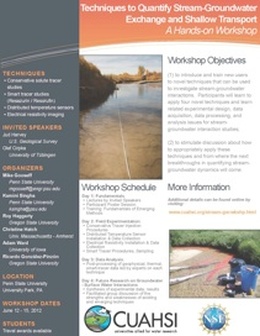
Techniques to Quantify Stream-Groundwater Exchange and Shallow Transport.
From 12-15 June 2011, we held a workshop to demonstrate several different techniques used currently to quantify stream-groundwater interactions. We had over 30 attendees, primarily graduate students. Day 1 was focused on theory behind the techniques, Day 2 was a full field day in which we conducted a stream tracer experiment on Shavers Creek, in central PA; Day 3 was a data and sample analysis day; and Day 4 was devoted to data interpretation. The group was enthusiastic and dedicated to the workshop. Our team of co-instructors and organizers included: Mike Gooseff, Roy Haggerty, Adam Ward, Judson Harvey, Olaf Cirpka, Ricardo Gonzalez, Kamini Singha, and Christine Hatch. Most importantly, we had extensive and essential assistance from Kayla Berry and Jennifer Arrigio from CUAHSI. The workshop was supported by a NSF grant to Drs. Singha and Gooseff as part of their outreach efforts, and by CUAHSI. |
|
Characterizing macropore flow in headwater streams.
The exchange of surface water and groundwater in stream and river corridors (hyporheic exchange) is important for aquatic organisms, ecosystem function, and water quality. While many factors control such exchange, hydraulic conductivity is often the most influential, spanning 8 orders of magnitude, and highly variable in space and time. Preferential flowpaths can develop along areas of higher hydraulic conductivity and dominate hyporheic flow. Macropores are a class of preferential flowpaths entirely devoid of porous media and hence of the highest hydraulic conductivity possible. Macropores are widely distributed in the subsurface but have only recently been acknowledged, and barely studied, within the hyporheic zone. To our knowledge, hyporheic macropores have never been mapped in a field setting. Yet such mapping is critical to addressing our motivating hydrologic question: how do macropores impact both total exchange and spatial distribution of exchange throughout stream and river corridors? Nevertheless, like all preferential flowpaths, it is extremely difficult to accurately map macropores with traditional hyporheic techniques (e.g., piezometers and conventional tracer tests) because of their extreme variability in space. In stark contrast, geophysical methods exhibit great promise to vastly increase the accuracy of hyporheic macropore mapping, and therefore hyporheic exchange and function. This research is being completed on an unnamed tributary to Tom’s Creek, near Blacksburg, Virginia, USA. Funding Source: CUAHSI HydroGeoPhysics Seed Grant PIs: Adam Ward, Erich Hester, PhD (Virginia Tech) Research Team: Garrett Menichino (Virginia Tech), Victoria Sickling |
|
Design of restoration structures for hyporheic exchange.
Despite the recognition of stream-aquifer interaction as a vital part of numerous ecosystem services, restoration design seldom considers hyporheic exchange as a design goal. Our research explores novel designs for subsurface restoration structures, and modification of common surface structures (e.g., cross-vanes, J-hooks) to enhance hyporheic exchange in study reaches. Collaborators: Mike Gooseff (Colorado State University), Peggy Johnson (Penn State University) |
|
Sustainable Stormwater Management.
Research completed for my M.S. degree focused on management of urban runoff. Specifically, I investigated the design and implementation of biodetention structure (a.k.a. bioretention, rain gardens, etc.) and compliance with local, state, and federal regulations. My work included a lifecycle assessment of alternative infrastructure schemes (traditional pipe-and-basin vs. novel low-impact scheme). MS Committee: David Watkins (Michigan Technological University), John Gierke (Michigan Technological University), Mary Durfee (Michigan Technological University), Brian Barkdoll, (Michigan Technological University) |
|
Aquifer Supply & Development.
As an undergraduate I worked as a member of Aqua Terra Tech, a student-run consulting firm focused on management of natural resources. My work included modeling both surface and groundwater for the Keweenaw Bay Indian Community, who was interested in assessing the impacts of development on their natural resources and understanding the potential for contamination of the local aquifer. Specifically, we investigated the potential for mining operations, and associated discharges of water laden with multiple pollutants, to impact surface and ground waters. Adviser: John Gierke (Michigan Technological University) |
